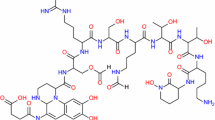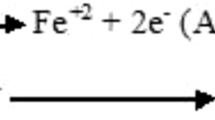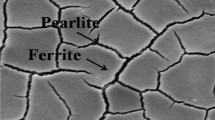Abstract
The data reported in this investigation revealed that phosphate and hydrogenase can affect the corrosion of mild steel. Phosphate reacted on mild-steel with concomitant evolution of hydrogen gas (H2) and the formation of vivianite. The enzyme hydrogenase was shown to accelerate this reaction by oxidizing the H2 produced, its known substrate. The components of biological growth media, one of which has been identified as phosphate, can interact with mild steel and cause corrosion. The implications of these findings to the corrosion industry are discussed.
Similar content being viewed by others
References
Belay N, Daniels L (1990) Elemental metals as electron sources for biological metane formation from CO2. Antoine van Leeuwenhoek 57:1–7
Bryant RD, Laishley EJ (1990) The role of hydrogenase in anaerobic biocorrosion. Can J Microbiol 36:259–264
Bryant RD, Jansen W, Boivin J, Laishley EJ, Costerton JW (1991) Effect of hydrogenase and mixed sulfate-reducing bacterial populations on the corrosion of steel. Appl Environ Microbiol 57:2804–2809
Cord-Ruwisch R, Widdel F (1986) Corroding iron as a hydrogen source for sulphate-reduction in growing cultures of sulphate-reducing bacteria. Appl Microbiol Biotechnol 25:169–174
Daniels L, Belay N, Rajagopal BS, Weimer PJ (1987) Bacteriol methanogenesis and growth from CO2 with elemental iron as the sole source of electrons. Science 237:509–511
Gornall AG, Bardawill CJ, David MM (1949) Determination of serum proteins by means of the biuret reaction. J Biol Chem 177:751–766
Hamilton WA (1985) Sulphate reducing bacteria and anaerobic corrosion. Annu Rev Microbiol 39:195–217
Laishley EJ, Krouse HR (1978) Stable isotope fractionation by Clostridium pasteurianum. 2. Regulation of sulfite reductases by sulfur amino acids and their influence on sulfur isotype fractionation during SO 2−3 and SO 2−4 reduction. Can J Microbiol 24:716–724
Mahler HR, Elowe DG (1954) Studies on metalloflavoproteins. II. The role of iron in diphosphopyridine nucleotide cytochrome C reductase. J Biol Chem 210:165–179
Rajagopal BS, LeGall J (1989) Utilization of cathodic hydrogen by hydrogen-oxidizing bacteria. Appl Microbiol Biotechnol 31:406–412
Wemier PJ, Kavelaar MJ van, Michel CB, Ng TK (1988) Effect of phosphate on the corrosion of carbon steel and on the composition of corrosion products in two-stage continuous culture of Desulfovibrio desulfuricans. Appl Environ Microbiol 54:386–396
Wolzogen Kühr CAH von, Vlugt IS van der (1934) Graphication of cast iron as an electrochemical process in anaerobic soils. Water 18:147–165
Author information
Authors and Affiliations
Additional information
Correspondence to: E. Laishley
Rights and permissions
About this article
Cite this article
Bryant, R., Laishley, E. The effect of inorganic phosphate and hydrogenase on the corrosion of mild steel. Appl Microbiol Biotechnol 38, 824–827 (1993). https://doi.org/10.1007/BF00167152
Received:
Accepted:
Issue Date:
DOI: https://doi.org/10.1007/BF00167152




